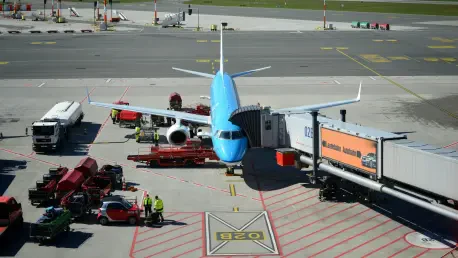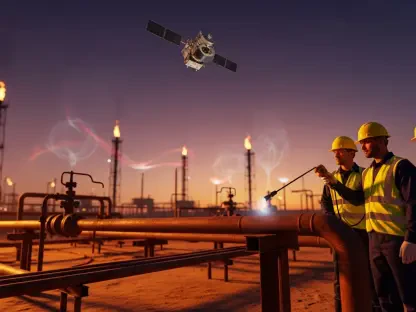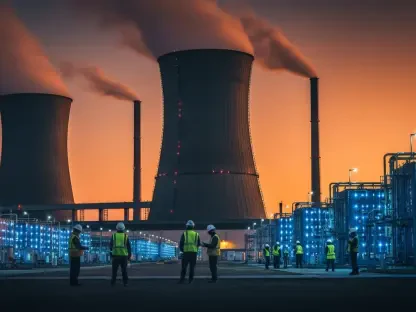The aviation sector is navigating a pivotal moment in its history, grappling with the dual challenge of meeting soaring global demand for air travel while slashing its substantial carbon emissions, a task made urgent by the industry’s significant contribution to greenhouse gas output. As one of the most energy-intensive industries, aviation must prioritize sustainability not as a mere trend but as an immediate necessity. Recent developments, as highlighted in industry reports from October and November, reveal a sharp focus on sustainable aviation fuel (SAF) as the linchpin of decarbonization strategies. This alternative to traditional jet fuel, derived from renewable sources, offers a tangible pathway to reduce emissions without requiring wholesale changes to existing aircraft or infrastructure. Beyond fuel innovation, the industry is witnessing a convergence of technological advancements, policy support, and international partnerships, all aimed at reshaping air travel into a greener mode of transportation. This collective effort underscores a broader recognition that environmental responsibility must be embedded in every facet of aviation’s growth. Regulatory pressures, coupled with societal expectations for eco-friendly solutions, are driving stakeholders to act swiftly and decisively. As the following sections explore, the momentum behind SAF and related initiatives signals a transformative era for the industry, one where sustainability is no longer an aspiration but a measurable goal within reach. The journey, however, is complex, requiring coordinated action across borders and sectors to achieve the ambitious net-zero targets set for the coming decades.
Pioneering Innovations in Fuel Technology
The race to decarbonize aviation has sparked remarkable innovations in sustainable aviation fuel production, positioning it as a cornerstone of the industry’s environmental strategy. Companies are breaking new ground with technologies that convert renewable resources into viable jet fuel alternatives, reducing reliance on fossil-based options. A notable achievement comes from a US-based firm that recently pioneered the production of ethanol-derived SAF at a major refinery. This milestone proves that such fuels can be manufactured at scale, offering a glimpse into a future where sustainable options could power a significant portion of commercial flights. The implications are profound, as this technology addresses both emission reductions and compatibility with current aircraft designs, minimizing the need for costly overhauls. As production methods refine and costs decrease, the adoption of SAF is poised to accelerate, potentially transforming it from a niche solution into a mainstream standard across global fleets.
Equally inspiring is the expansion of SAF infrastructure into diverse regions, showcasing the technology’s adaptability to varying economic and geographic contexts. In Australia, partnerships are forming to establish new production plants, while in Central Asia, agreements with national energy entities are laying the groundwork for regional SAF hubs. These initiatives are not merely isolated projects but part of a broader movement to create a robust supply network capable of supporting international aviation demands. By building facilities closer to key markets, these efforts reduce transportation costs and carbon footprints associated with fuel distribution. Moreover, they demonstrate a commitment to inclusivity, ensuring that emerging economies are not left behind in the transition to sustainable aviation. This global spread of innovation highlights the industry’s determination to tackle decarbonization holistically, addressing both technological and logistical challenges with equal vigor.
Policy Frameworks Driving Sustainable Change
Government intervention is emerging as a critical force in propelling the aviation industry toward a low-carbon future, with policies designed to incentivize and sustain SAF adoption. In Europe, a comprehensive investment plan has been rolled out to boost funding for low-emission fuels, signaling a strong commitment to transforming transportation sectors. This initiative not only provides financial support for research and production but also sets a precedent for how regulatory bodies can steer industries toward sustainability. By prioritizing green fuel development, such policies address the economic barriers that have historically slowed SAF uptake, ensuring that producers have the resources needed to scale operations. The ripple effect is evident as airlines and manufacturers align their strategies with these guidelines, fostering a unified push for environmental progress.
Across other regions, tailored approaches are yielding equally promising results in overcoming market challenges associated with sustainable fuels. The UK, for instance, has initiated consultations on mechanisms to guarantee revenue stability for SAF producers, a move aimed at reducing financial risks and encouraging investment. Meanwhile, Singapore has taken a unique step by creating a centralized agency to manage SAF procurement for its primary airport, ensuring a reliable supply chain for airlines operating in the hub. These diverse strategies underscore a shared understanding that policy must be adaptable to local needs while maintaining a global vision for decarbonization. By bridging financial gaps and streamlining logistics, governments are not just facilitating change but actively shaping the trajectory of aviation’s environmental efforts, making sustainability a feasible and attractive option for all stakeholders involved.
Collaborative Efforts on a Global Scale
Decarbonizing aviation is a challenge too vast for any single entity to tackle alone, prompting an unprecedented wave of international partnerships that pool resources and expertise. Collaborations between financial institutions and engineering firms are opening new frontiers, particularly in regions like Africa, where joint ventures are exploring SAF production possibilities. These alliances are crucial for bringing sustainable fuel technologies to areas that might otherwise lack the infrastructure or funding to develop them independently. By leveraging cross-continental knowledge and investment, such partnerships ensure that the benefits of decarbonization are distributed equitably, fostering a sense of global solidarity in addressing climate challenges. The impact extends beyond fuel production, as these initiatives also create economic opportunities and build local capacities for green innovation.
Similarly, strategic alignments within the industry itself are amplifying efforts to fund and promote sustainable aviation solutions. A notable example is the investment partnership between a major airline and an aircraft manufacturer in Singapore, which combines operational and technical expertise to advance SAF development. This collaboration exemplifies how different segments of the aviation ecosystem can work together to overcome shared obstacles, from high production costs to limited market access. By aligning their goals, these partners not only accelerate the adoption of sustainable fuels but also set a model for others to follow, proving that collective action can yield faster and more impactful results. Such cooperative endeavors highlight a fundamental shift in the industry’s mindset, where competition gives way to synergy in the pursuit of a common environmental objective, ensuring that progress is both rapid and inclusive.
Balancing Growth with Environmental Responsibility
As air travel continues to expand globally, the aviation industry faces the intricate task of balancing this growth with its environmental responsibilities. Recent analyses reveal that passenger jet operations have reached record levels of emissions, underscoring the urgent need for sustainable practices amid rising demand. This tension between expansion and ecological impact is a central concern, as unchecked growth could undermine decarbonization gains. Sustainable aviation fuel offers a promising avenue to mitigate this issue, allowing airlines to maintain service levels while curbing their carbon footprint. However, integrating SAF into widespread use requires overcoming hurdles such as limited supply and higher costs compared to conventional fuels. The industry must prioritize strategies that align operational scalability with emission reduction targets to ensure long-term viability.
Beyond fuel solutions, the debate over complementary decarbonization strategies adds another layer of complexity to achieving sustainability goals. Some experts advocate for synthetic fuels produced with renewable energy, while others emphasize carbon removal technologies as vital components of a holistic approach. Rather than viewing these methods as competing, there is growing consensus that they should work in tandem to address different facets of the emission challenge. This nuanced perspective encourages stakeholders to adopt a multi-pronged strategy, ensuring that no single solution bears the full burden of transformation. By embracing diverse technologies and fostering dialogue on their integration, the aviation sector can create a more resilient framework for sustainability, one that accommodates growth without sacrificing environmental commitments. This balanced approach is essential for navigating the intricate path ahead.
Charting the Path Forward for Sustainable Aviation
Reflecting on the strides made in recent months, the aviation industry has demonstrated remarkable resolve in confronting its carbon footprint through a multifaceted approach. Groundbreaking advancements in sustainable aviation fuel production marked significant progress, with pioneering companies showcasing the potential to shift away from fossil fuels. Robust policy frameworks across regions like Europe and Asia provided the financial and regulatory scaffolding needed to support this transition, while international collaborations bridged gaps in resources and expertise. The challenge of balancing soaring passenger demand with environmental imperatives came into sharp focus, prompting deeper discussions on integrating diverse decarbonization strategies.
Looking ahead, the next steps involve scaling these efforts to match the industry’s global scope, ensuring that innovations and partnerships translate into widespread impact. Stakeholders must prioritize expanding SAF supply chains, reducing production costs, and standardizing regulations to create a cohesive market for sustainable fuels. Additionally, investing in research for complementary technologies, such as carbon capture and synthetic fuels, will fortify the sector’s resilience against future challenges. By maintaining this momentum and fostering inclusive dialogue among governments, businesses, and communities, aviation can chart a sustainable course that meets both current demands and future aspirations. This collective journey, rooted in innovation and cooperation, holds the promise of redefining air travel as a force for environmental good.









